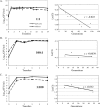Fitness cost of VanA-type vancomycin resistance in methicillin-resistant Staphylococcus aureus
- PMID: 19332680
- PMCID: PMC2687198
- DOI: 10.1128/AAC.01702-08
Fitness cost of VanA-type vancomycin resistance in methicillin-resistant Staphylococcus aureus
Abstract
We have quantified the biological cost of VanA-type glycopeptide resistance due to the acquisition of the resistance operon by methicillin-resistant Staphylococcus aureus (MRSA) from Enterococcus sp. Exponential growths of recipient strain HIP11713, its transconjugant VRSA-1, VRSA-5, and VRSA-6 were compared in the absence or, except for HIP11713, in the presence of vancomycin. Induction of resistance was performed by adding vancomycin in both the preculture and the culture or the culture at only 1/50 the MIC. In the absence of vancomycin, the growth rates of the vancomycin-resistant S. aureus (VRSA) strains were similar to that of susceptible MRSA strain HIP11713. When resistance was induced, and under both conditions, there was a significant reduction of the growth rate of the VRSA strains relative to that of HIP11713 and to those of their noninduced counterparts, corresponding to a ca. 20% to 38% reduction in fitness. Competition experiments between isogenic VRSA-1 and HIP11713 mixed at a 1:1, 1:100, or 100:1 ratio revealed a competitive disadvantage of 0.4% to 3% per 10 generations of the transconjugant versus the recipient. This slight fitness burden can be attributed to the basal level of expression of the van genes in the absence of induction combined with a gene dosage effect due to the presence of the van operon on multicopy plasmids. These data indicate that VanA-type resistance, when induced, is highly costly for the MRSA host, whereas in the absence of induction, its biological cost is minimal. Thus, the potential for the dissemination of VRSA clinical isolates should not be underestimated.
Figures


References
-
- Andersson, D. I., and B. R. Levin. 1999. The biological cost of antibiotic resistance. Curr. Opin. Microbiol. 2:489-493. - PubMed
-
- Arthur, M., F. Depardieu, P. Reynolds, and P. Courvalin. 1996. Quantitative analysis of the metabolism of soluble cytoplasmic peptidoglycan precursors of glycopeptide-resistant enterococci. Mol. Microbiol. 21:33-44. - PubMed
-
- Arthur, M., P. Reynolds, and P. Courvalin. 1996. Glycopeptide resistance in enterococci. Trends Microbiol. 4:401-407. - PubMed
Publication types
MeSH terms
Substances
LinkOut - more resources
Full Text Sources
Medical

